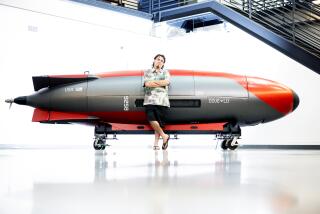Next Time, Plain Vanilla
- Share via
Pentagon officials who complain about the amount of attention given to military purchases of $900 coffee makers or $600 toilet seats may have a point. Outlays like these really are chicken feed and hardly worth serious notice, at least compared to the grotesque squandering of public money that goes on with more necessary procurement. That’s particularly the case when the armed services insist on taking a relatively simple idea and turning it into a gold-plated disaster. Consider, as a recent example, something called the Aquila.
Way back in 1974, the Army launched a program to develop a small, pilotless aircraft, the Aquila, that could be flown by remote control over a battlefield and rigged to perform various surveillance functions. It sounds simple enough. Yet somehow this simple program has been 13 years in the works, and its end is still nowhere in sight. The program is already seven years behind schedule, while its original estimated cost of $563 million has at least quadrupled. With a plenty of luck, the Aquila might become operational by 1992. For a price of well over $2 billion, the Army hopes to get 376 drones and support equipment, a fewer number of these units than the program originally envisaged.
What’s gone wrong with the Aquila? A lot. The latest problem, according to Defense Week, an industry newsletter, showed up in recent extensive field tests. What the tests found is that while the Aquila was indeed able to locate various moving and stationary targets, its remote operators had a lot of trouble seeing for themselves what the plane detected. Apparently the human crew on the other end of the technology was able to find only one in five of the moving targets and one in eight of the stationary targets located by the drone. The technology worked, at least most of the time, but that’s small comfort if the information it produces proves to be largely unusable.
A big part of the problem clearly is that the Aquila has been made too complicated for its own good. It seems to be yet another case of trying to do more with a piece of equipment than basic mission requirements indicate should be done. Things didn’t have to turn out this way. The Army could have had a cheap, simple and efficient drone of limited but still impressive capability, and it could have had one years ago. Instead, as the Aquila project went along, its price soared under the imperative that it not only adhere to absurdly rigid military specifications, but that it also be loaded down with far more gadgets than design plans originally called for.
Simple, cheap and proven battlefield surveillance drones, built mainly from off-the-shelf parts, do exist. In 1982, for example, Israel used its home-made drones to great effect in combat against the Syrian army in Lebanon. According to a story in Washington Monthly three years ago, U.S. forces could have been equipped either with the Israeli-made drone or a similar American-made drone made by one of several companies. These remotely piloted vehicles to a great extent were put together with off-the-shelf parts, and could be bought for about $50,000 a copy. The Army, though, didn’t want a plain vanilla model. It wanted one equipped with the latest and best technology. Such things don’t come cheap. As of now it appears that the Aquila will end up costing well over $800,000 a unit. Moreover there’s no assurance that it will be able to stand up to the kind of repeated use that cheaper versions are known to be capable of.
The Pentagon complains that it gets a bum rap on aberrations like the overpriced toilet seat. We’re inclined to agree. It’s obvious that the real scandal in defense costs is a lot bigger, and a lot more worrisome in its implications for national security.
More to Read
Inside the business of entertainment
The Wide Shot brings you news, analysis and insights on everything from streaming wars to production — and what it all means for the future.
You may occasionally receive promotional content from the Los Angeles Times.










